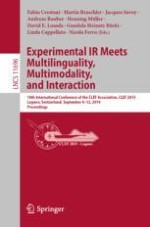This book constitutes the refereed proceedings of the 10th International Conference of the CLEF Association, CLEF 2019, held in Lugano, Switzerland, in September 2019.
The conference has a clear focus on experimental information retrieval with special attention to the challenges of multimodality, multilinguality, and interactive search ranging from unstructured to semi structures and structured data. The 7 full papers and 8 short papers presented in this volume were carefully reviewed and selected from 30 submissions. This year, many contributions tackle the social networks with the detection of stances or early identification of depression signs on Twitter in a cross-lingual context.
Further this volume presents 7 “best of the labs” papers which were reviewed as a full paper submission with the same review criteria. The labs represented scientific challenges based on new data sets and real world problems in multimodal and multilingual information access. In addition to this, 9 benchmarking labs reported results of their yearlong activities in overview talks and lab sessions.
